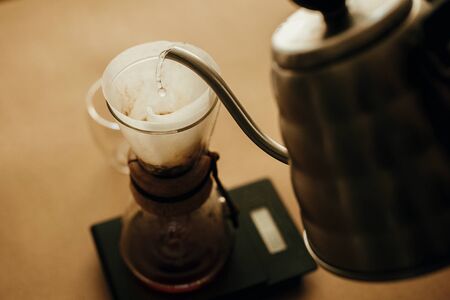Introduction to the Cafetière
The Cafetière, known globally as the French Press, holds a special place in British coffee culture. First introduced to the UK in the mid-20th century, this iconic brewing device quickly found favour among Britons seeking an accessible yet flavourful way to enjoy coffee at home. Unlike espresso machines or drip brewers, the Cafetière offers a hands-on approach that aligns with the British appreciation for simplicity and quality. Its enduring popularity can be attributed to its ability to deliver a rich, full-bodied cup while allowing users to tailor strength and flavour to their personal taste. Whether you’re preparing a leisurely Sunday breakfast or hosting afternoon guests, the Cafetière has become a staple in UK homes, admired for both its ease of use and the consistently satisfying brew it produces.
2. Selecting the Right Coffee and Equipment
Choosing the right coffee and equipment is crucial to achieving a satisfying cup with your cafetière. Start by selecting high-quality, freshly roasted coffee beans. For a classic British cafetière experience, opt for single-origin beans or a well-balanced blend that offers notes of chocolate, nuts, or gentle fruitiness. Avoid pre-ground supermarket coffee as it tends to be stale and lacks complexity.
Coffee Bean Selection
| Bean Type | Flavour Profile | Recommended For |
|---|---|---|
| Single Origin (Ethiopian) | Floral, Citrus, Bright Acidity | Light, vibrant brews with complexity |
| Single Origin (Colombian) | Nutty, Caramel, Balanced Body | Classic British-style cups with balance |
| Blend (House Blend) | Chocolatey, Nutty, Smooth Finish | Everyday brews; approachable and versatile |
The Best Grind Size for a Cafetière
The grind size is just as important as bean quality. A coarse, even grind is essential for cafetière brewing. Too fine and you’ll end up with a muddy cup; too coarse and your brew may taste weak and watery. Aim for a consistency similar to sea salt or rough sand.
Coffee Grind Comparison Table
| Grind Size | Description | Suitability for French Press |
|---|---|---|
| Fine (Espresso) | Powdery, like table salt | Poor – causes over-extraction and sludge |
| Medium (Drip) | Sandy, like caster sugar | Mediocre – can slip through filter mesh |
| Coarse (French Press) | Chunky, like sea salt crystals | Ideal – clean cup, proper extraction |
Selecting Your French Press (Cafetière)
A good cafetière should be robust enough for daily use yet elegant enough to take pride of place on your kitchen counter. Look for models with durable borosilicate glass or stainless steel bodies—both are popular in the UK due to their resilience against thermal shock and accidental knocks. The plunger mechanism should offer a snug fit to prevent grounds from escaping into your cup. Consider capacity: most British households find an 8-cup model (around 1 litre) perfect for sharing tea-time moments or leisurely Sunday mornings.
Checklist for Quality French Press Selection:
- Borosilicate Glass or Stainless Steel: Superior heat retention and durability.
- Tight-Fitting Plunger: Prevents grounds slipping past the mesh filter.
- Comfortable Handle: For safe pouring even when hot.
- Aesthetics: Choose a style that complements your kitchen décor—after all, this is Britain!
Selecting the right beans, grind size, and cafetière will lay the foundation for a truly enjoyable home-brewed coffee that rivals your local café’s best efforts.

3. Measuring Coffee and Water: Getting the Ratio Spot On
Nailing the correct coffee-to-water ratio is a cornerstone of brewing an excellent cup with your cafetière—a tradition that British coffee enthusiasts hold dear. Unlike espresso or filter methods, the French press allows for a richer, more robust extraction, but achieving balance requires precision. The classic British approach recommends starting with a ratio of 1:15—one part freshly ground coffee to fifteen parts hot water by weight. For instance, if you’re brewing a single mug (approximately 300ml), use around 20 grams of coffee. This proportion delivers a cup that’s neither too strong nor too weak, capturing the nuanced flavours and aromas of your beans. If you prefer a lighter brew, adjust to a 1:17 ratio; for something bolder, edge closer to 1:12. Always use filtered water just off the boil (about 93–96°C), as tap water can impart unwanted flavours. Weighing both your coffee and water using digital kitchen scales ensures consistency—a hallmark of British home brewing standards. Once you’ve found your preferred ratio, make a note for future reference; this attention to detail transforms an ordinary cup into an exceptional one every time.
4. The Brewing Process: Step-by-Step
Mastering the cafetière, or French press, is all about precision and a touch of patience. Let’s break down the brewing process into clear, manageable steps to ensure your first cup is as satisfying as a proper British cuppa. From dosing your grounds to pressing the plunger, follow this straightforward guide:
Step 1: Add Coffee Grounds
Measure out your freshly ground coffee. For a classic strength, use a ratio of roughly 1:15 – that’s one part coffee to fifteen parts water by weight. A standard measure for a 350ml cafetière is about 23g of coffee.
| Cafetière Size | Coffee (g) | Water (ml) |
|---|---|---|
| 350ml (3-cup) | 23g | 350ml |
| 800ml (8-cup) | 53g | 800ml |
Step 2: Add Water
Heat your water to just off the boil—aim for around 92-96°C. Pour evenly over the grounds, ensuring full saturation. Stir gently with a wooden spoon or plastic stirrer to make sure all grounds are wet; metal can crack glass beakers and impart an unwanted taste.
Step 3: Steep and Wait
Place the lid on your cafetière with the plunger pulled up. Allow the coffee to steep for 4 minutes. This extraction time is key for a balanced brew; less time risks under-extraction, while more may introduce bitterness.
Step 4: Break the Crust and Skim
After steeping, gently break the crust of floating grounds with a spoon and give it a light stir. Skim off any foam or remaining floating grounds for a cleaner cup—a technique favoured by many specialty cafés in the UK.
Step 5: Press the Plunger
Hold the lid firmly and press the plunger down slowly and steadily. Rushing this step could agitate fines and muddy your brew, so take your time—think of it as the final flourish before you pour.
Troubleshooting Common Issues
| Issue | Possible Cause | Solution |
|---|---|---|
| Bitter Taste | Over-steeping or too fine grind | Brew for less time or use coarser grind |
| Weak Flavour | Under-steeping or too coarse grind | Brew longer or use finer grind |
This methodical approach ensures each step contributes to clarity and balance in your cup—the hallmark of well-brewed cafetière coffee enjoyed throughout Britain.
5. Serving Suggestions: The British Way
Brewing a cup of coffee with a cafetière is only half the journey; how you serve it can elevate the experience and reflect British coffee culture. Traditionally, Brits have preferred their cafetière coffee served with a splash of milk, lending a smooth texture and mellowing any robust flavours—an echo of the nations longstanding relationship with tea. For those who appreciate a richer cup, double cream or even a dash of oat milk can be delightful modern alternatives.
Pairing with Classic Biscuits
No British coffee ritual is complete without something to nibble on the side. Timeless favourites include digestives, rich tea biscuits, or shortbread—each offering a satisfying crunch that complements the full-bodied profile of French press coffee. Dunking your biscuit into your freshly brewed cup is not only accepted, but encouraged for an authentic touch.
Exploring Modern Twists
The contemporary British palate welcomes experimentation: try your cafetière coffee black to savour its natural tasting notes or add a sprinkle of cinnamon for warmth during colder months. Pairing coffee with pastries such as croissants or pain au chocolat reflects the cosmopolitan influence found in many UK cafés today.
Enjoying Your Coffee Moment
Whether youre indulging in a solitary morning ritual or hosting friends for an afternoon catch-up, serving cafetière coffee ‘the British way’ centres around comfort and conviviality. Set out your best mugs, offer guests their choice of milk or sugar, and always have a tin of quality biscuits at hand. In true British fashion, its less about perfection and more about making everyone feel welcome.
6. Cleaning and Caring for Your Cafetière
Once you’ve savoured your freshly brewed cup, it’s essential to give your cafetière a bit of TLC to ensure it continues delivering top-notch coffee day in, day out. Proper maintenance not only keeps your French Press in peak condition but also preserves the clean, nuanced flavours you expect from each brew.
Daily Cleaning Routine
After every use, dismantle your cafetière by separating the plunger, filter, and carafe. Discard the used grounds—composting them is a great sustainable option favoured here in the UK. Rinse all components thoroughly with warm water to remove any lingering oils or residues that could taint future brews. For stubborn stains or oily build-up, use a mild washing-up liquid and a soft sponge; avoid anything abrasive that could scratch the glass or stainless steel.
Deep Cleaning Tips
Once a week, give your cafetière a more thorough clean. Soak all parts in a solution of warm water and a teaspoon of bicarbonate of soda (baking soda), which naturally lifts coffee oils without harsh chemicals. After soaking for 10-15 minutes, scrub gently and rinse well under running water. Make sure to pay extra attention to the mesh filter as trapped grounds can quickly affect flavour clarity.
Drying and Storage
Always dry each part completely before reassembling or storing your cafetière. This prevents mould growth and keeps everything fresh. Store your French Press with the plunger off to one side or slightly raised—this allows air circulation and avoids compressing the filter, helping it maintain its shape.
Maintaining Longevity
If you notice any tears in the mesh filter or cracks in the glass beaker, replace these components promptly; many UK kitchen shops carry spare parts for popular cafetière brands. Regularly checking seals and fittings ensures your press remains leak-free and safe for daily brewing.
Avoiding Common Pitfalls
Never put your glass carafe straight onto a hob or expose it to sudden temperature changes, as this can cause cracking—a common mishap in British kitchens! When cleaning, steer clear of dishwashers unless specifically marked as dishwasher safe, as high temperatures can damage plastic or rubber components over time.
With just a few minutes’ care after each use, your cafetière will reward you with consistently delicious cups and remain a cherished part of your morning routine—British reliability at its finest.

